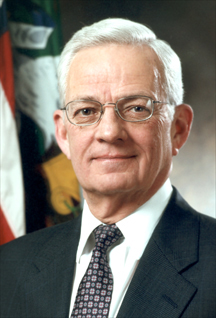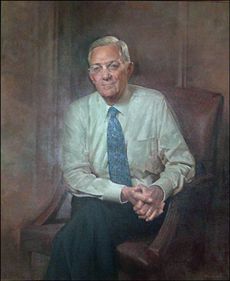Paul H. O'Neill facts for kids
Quick facts for kids
Paul H. O'Neill
|
|
|---|---|

Official portrait, 2001
|
|
| 72nd United States Secretary of the Treasury | |
| In office January 20, 2001 – December 31, 2002 |
|
| President | George W. Bush |
| Preceded by | Lawrence Summers |
| Succeeded by | John W. Snow |
| Personal details | |
| Born |
Paul Henry O'Neill
December 4, 1935 St. Louis, Missouri, U.S. |
| Died | April 18, 2020 (aged 84) Pittsburgh, Pennsylvania, U.S. |
| Political party | Republican |
| Spouse | Nancy O'Neill (née Jo Wolfe) |
| Children | 4 |
| Education | California State University, Fresno (BA) Indiana University Bloomington (MPA) |
| Signature | |
Paul Henry O'Neill (December 4, 1935 – April 18, 2020) was an American businessman and government official. He served as the 72nd Secretary of the Treasury for President George W. Bush. This important role lasted from January 2001 to December 2002. Before this, O'Neill was the leader of a big industrial company called Alcoa. He also chaired the RAND Corporation, a research organization.
Contents
Early Life and Education
Paul O'Neill was born in St. Louis, Missouri. His father was an army sergeant. Because of his father's job, Paul's family moved around a lot. They lived in places like Illinois, Hawaii, New Mexico, and Alaska.
As a teenager, Paul worked part-time jobs. He was a paperboy and a clerk at a convenience store. He finished high school in Anchorage, Alaska in 1954. Paul went on to earn a Bachelor of Arts degree in economics. He also received a Master of Public Administration from Indiana University.
Career in Public Service
Paul O'Neill started his career working for the government. From 1961 to 1966, he was a computer systems analyst. He worked for the United States Department of Veterans Affairs. In 1967, he joined the U.S. Office of Management and Budget. He became its deputy director from 1974 to 1977.
In 1973, O'Neill and two colleagues stood up to President Richard Nixon. Nixon wanted to cut funding to a university. This was because of anti-war protests. O'Neill and his colleagues threatened to resign. They reminded Nixon that he could not stop federal grants. This made the President change his mind.
Private Sector Roles
After leaving government service, O'Neill worked in the business world. He took an executive job at International Paper in New York City. He was a vice president and later president of the company.
Leading Alcoa
From 1987 to 1999, O'Neill was the chairman and CEO of Alcoa. This was a large industrial company in Pittsburgh. When he started, he focused a lot on worker safety. This was a new idea for many at the time. Under his leadership, Alcoa grew a lot. Its value increased from $3 billion to over $27 billion.
RAND Corporation and Other Ventures
In 1988, O'Neill joined the RAND Corporation. He became the chairperson of its board in 1997. He left this role when he became Treasury Secretary. After leaving government, he rejoined RAND's board.
He also became an advisor for The Blackstone Group. O'Neill helped start a company called Qcept Technologies Inc. In 2005, he created a consulting firm called Value Capture. This firm helps hospitals save money and improve patient safety.
Community Service and Healthcare Focus
O'Neill was also active in community service. In 1989, President George H. W. Bush asked him to be Secretary of Defense. O'Neill declined but suggested Dick Cheney for the job. O'Neill then chaired a group that advised on education.
In 1997, O'Neill helped start the Pittsburgh Regional Health Initiative (PRHI). This group worked to improve healthcare in the Pittsburgh area. They used ideas from the Toyota Production System to make patient care better. O'Neill became a national leader in patient safety.
He also helped create Pittsburgh's Riverlife Task Force in 1999. This group worked to improve the city's riverfronts. O'Neill was also on advisory boards for Carnegie Mellon University and the Committee for a Responsible Federal Budget.
In 2006, O'Neill published a study. It showed how teamwork could reduce infections in hospitals. He rejoined PRHI as its CEO in 2003. He also served as a trustee for the University of Pittsburgh Medical Center. He left this role because of disagreements about improving hospital safety.
In 2019, he received the Gerald R. Ford Medal for Distinguished Public Service.
Serving in the Bush Administration
In January 2001, Paul O'Neill became the United States Secretary of the Treasury. President George W. Bush appointed him to this role. As Secretary, he believed in careful spending and increasing productivity. He also wanted to protect workers' jobs.
O'Neill helped guide the U.S. economy through the 2001 recession and the 9/11 attacks. He supported the first tax cuts under Bush. However, he strongly disagreed with the second round of tax cuts. He also had different views on steel tariffs and actions against Cuba.
He helped countries like Turkey, Argentina, and Brazil get loans. These loans came from the International Monetary Fund. O'Neill also pushed for more grants from the World Bank. He worked to stop money from going to terrorist groups. He encouraged governments to regulate less traditional ways of sending money.
In May 2002, O'Neill visited Africa with singer Bono. They wanted to bring attention to poverty there. O'Neill was known for speaking his mind. This outspokenness eventually led to him leaving his job in December 2002.
After his time as Secretary, a book was written about O'Neill's experiences. The book, called The Price of Loyalty, shared many of his disagreements with the Bush administration.
Personal Life and Legacy
Paul O'Neill was married to Nancy Jo Wolfe. They met in high school. They had four children: three daughters and a son.
Death
Paul O'Neill passed away at his home in Pittsburgh on April 18, 2020. He was 84 years old and died from lung cancer. He was survived by his sister, brother, four children, twelve grandchildren, and fifteen great-grandchildren.
Views on Healthcare
In 2007, O'Neill wrote an article for The New York Times. He talked about the need for big changes in the U.S. health care system. He suggested that doctors and hospitals should report medical errors quickly. He also thought that lawsuits about medical mistakes should be handled by a new, independent group. He believed that healthcare reform should look at all parts of the problem. This included insurance, costs, quality of care, and technology.
In 2016, O'Neill joined seven other former Treasury secretaries. They all called for the United Kingdom to stay in the European Union. This was before a vote on the issue.
See also
 In Spanish: Paul O'Neill (secretario) para niños
In Spanish: Paul O'Neill (secretario) para niños


